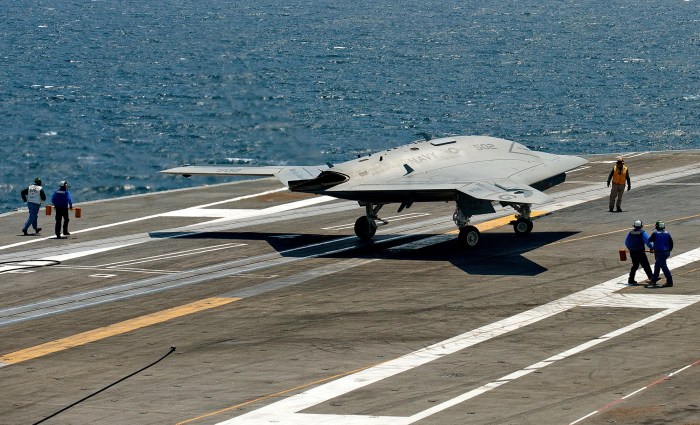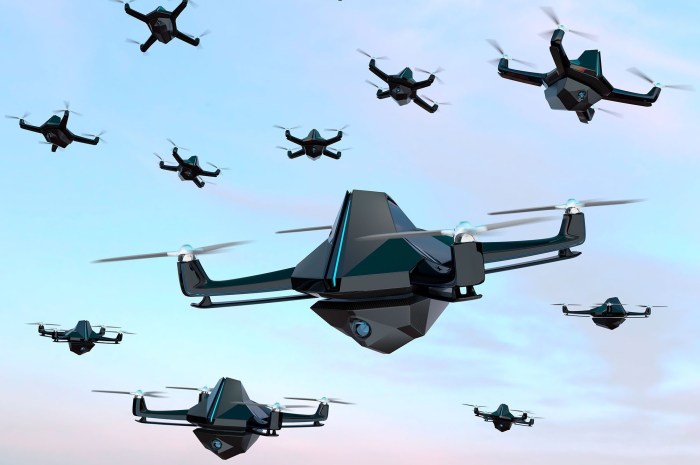The emergence of unmanned aerial vehicles (UAVs), commonly known as drones, has dramatically reshaped the landscape of modern warfare. While drones have been used in various military applications for decades, their role in naval operations is rapidly evolving. The concept of swarming drones, where multiple autonomous drones operate in a coordinated fashion, has emerged as a potent force multiplier, offering significant advantages in terms of reconnaissance, surveillance, and even offensive capabilities.
The use of drones in naval operations offers several advantages over traditional naval assets.
Advantages of Drone Swarms
Drones are inherently more cost-effective than traditional naval assets. The development and deployment of drones are significantly less expensive compared to the construction and maintenance of warships.
- Drones are smaller and more agile than traditional naval vessels, making them more difficult to detect and engage.
- Drones can be deployed in large numbers, overwhelming enemy defenses and providing a significant force multiplier.
- Drones can be equipped with a variety of sensors and payloads, making them versatile for a range of missions.
- Drones can operate in dangerous or inaccessible environments, such as minefields or contested airspace.
Challenges and Limitations of Drone Swarms
While drone swarms offer numerous advantages, they also present challenges and limitations in naval environments.
- Drones are vulnerable to electronic warfare (EW) and cyberattacks. Disrupting the communication and control systems of drone swarms can render them ineffective.
- Drones have limited endurance and range, requiring frequent refueling or battery changes.
- The effectiveness of drone swarms depends on the reliability of their navigation and communication systems. Environmental factors like weather and electromagnetic interference can disrupt these systems.
- The use of drone swarms raises ethical concerns regarding the potential for unintended consequences and the potential for autonomous weapons systems to make life-or-death decisions without human oversight.
The US Navy is actively pursuing the development and integration of drone swarming technology, recognizing its potential to revolutionize naval warfare. Their efforts encompass research, development, and experimentation, aiming to leverage the advantages of drone swarms in various naval operations.
Research and Development Efforts
The US Navy is investing heavily in research and development to enhance drone swarm capabilities. This includes:
* Autonomous Swarm Control: Developing algorithms and software for decentralized control of drone swarms, allowing them to operate independently and adapt to dynamic environments.
* Cooperative Behavior: Researching techniques for swarm coordination, enabling drones to work together effectively for tasks like reconnaissance, surveillance, and attack.
* Resilience and Survivability: Implementing measures to ensure swarm resilience against attacks and disruptions, including redundancy, fault tolerance, and self-healing capabilities.
* Integration with Existing Systems: Integrating drone swarms with existing naval platforms and systems, such as ships, aircraft carriers, and command and control centers.
The US Navy has conducted several exercises and demonstrations showcasing the potential of drone swarming:
* The “Sea Hunter” program: This program focuses on developing autonomous surface vessels capable of operating in swarms and carrying out various missions, including anti-submarine warfare and mine countermeasures.
* The “Cooperative Engagement Capability” (CEC) program: This program aims to enhance the ability of naval vessels to share information and coordinate actions with drone swarms, enabling them to operate as a single, cohesive force.
* The “Advanced Naval Technology Exercise” (ANTX): This annual exercise involves various naval platforms, including drone swarms, conducting simulated combat operations to test new technologies and tactics.
Key Technologies and Platforms
The US Navy is leveraging a range of technologies and platforms for drone swarm control and coordination:
* Unmanned Aerial Vehicles (UAVs): Various types of UAVs, including fixed-wing and rotary-wing aircraft, are being used for reconnaissance, surveillance, and attack missions.
* Unmanned Surface Vehicles (USVs): Autonomous surface vessels are being developed for a wide range of tasks, including mine countermeasures, anti-submarine warfare, and reconnaissance.
* Underwater Unmanned Vehicles (UUVs): Autonomous underwater vehicles are being used for reconnaissance, surveillance, and target identification in underwater environments.
* Software and Algorithms: Advanced software and algorithms are essential for swarm control, coordination, and decision-making.
* Communication Networks: Reliable and secure communication networks are crucial for maintaining swarm cohesion and coordinating actions.
“The US Navy is committed to developing and fielding drone swarms as a key component of its future naval force. The potential of this technology to enhance situational awareness, increase operational effectiveness, and deter adversaries is significant.” – US Navy official statement
Drone swarms, a collection of autonomous unmanned aerial vehicles (UAVs) coordinated to act as a single entity, are poised to revolutionize naval warfare. Their versatility and adaptability make them ideal for a wide range of missions, from reconnaissance and surveillance to electronic warfare and humanitarian assistance.
Reconnaissance, Surveillance, and Target Identification
Drone swarms can provide persistent and comprehensive situational awareness, enabling naval forces to gather real-time intelligence on enemy movements, activities, and capabilities.
- Swarms of small drones can be deployed to conduct aerial reconnaissance over vast areas, providing detailed imagery and video footage of enemy ships, installations, and terrain.
- Their small size and maneuverability allow them to infiltrate enemy territory undetected, providing valuable intelligence on enemy defenses, troop movements, and logistical operations.
- Equipped with advanced sensors, such as electro-optical/infrared cameras and synthetic aperture radar (SAR), drone swarms can identify and track targets, assess damage, and provide real-time updates to naval command centers.
Electronic Warfare, Communication Disruption, and Anti-Ship Warfare
Drone swarms can disrupt enemy communication networks, jam electronic signals, and even launch attacks against enemy ships.
- Equipped with electronic warfare (EW) payloads, drone swarms can disrupt enemy radar systems, communications, and navigation systems, creating confusion and hindering their ability to operate effectively.
- Drone swarms can act as decoys, drawing enemy fire away from valuable assets or confusing their targeting systems.
- Swarms of drones equipped with high-explosive payloads can be used to launch coordinated attacks against enemy ships, overwhelming their defenses and inflicting significant damage.
Mine Countermeasures, Search and Rescue, and Humanitarian Assistance
Drone swarms can be used to conduct mine countermeasures, search and rescue operations, and deliver humanitarian aid.
- Drone swarms equipped with sensors and imaging systems can be deployed to detect and identify underwater mines, providing valuable information for mine clearance operations.
- Their maneuverability and endurance allow them to search vast areas for survivors in maritime accidents, providing vital information to rescue teams.
- Drone swarms can be used to deliver essential supplies, such as food, water, and medicine, to disaster-stricken areas, providing critical support during humanitarian crises.
Ethical and Legal Considerations of Drone Swarms
The deployment of drone swarms in naval warfare raises significant ethical and legal concerns, particularly due to the potential for collateral damage and the implications of autonomous decision-making. Understanding the legal frameworks governing the use of drones in warfare and the potential challenges associated with the proliferation of this technology is crucial for responsible development and deployment.
Ethical Implications of Drone Swarms
The use of drone swarms in naval warfare presents several ethical challenges, including the potential for collateral damage and the implications of autonomous decision-making.
Collateral Damage
Drone swarms, by their very nature, can increase the risk of collateral damage. The sheer number of drones involved in a swarm attack could potentially lead to a wider impact on civilian populations and infrastructure.
The potential for unintended consequences, such as civilian casualties or damage to civilian infrastructure, is a serious concern.
Autonomous Decision-Making
The ability of drone swarms to operate autonomously raises ethical concerns regarding the delegation of life-or-death decisions to machines.
The lack of human oversight in autonomous decision-making systems could lead to unintended consequences and raise questions about accountability.
Legal Frameworks and International Agreements
The legal frameworks governing the use of drones in warfare are still evolving, and the specific application of existing international law to drone swarms remains unclear.
International Humanitarian Law
International humanitarian law (IHL) aims to protect civilians and limit the harm inflicted during armed conflict.
The principles of distinction, proportionality, and military necessity are central to IHL.
International Law on Autonomous Weapons Systems
The development of autonomous weapons systems, including drone swarms, has sparked debate within the international community.
The potential for autonomous weapons systems to violate IHL principles and the need for human control over lethal decisions are key areas of discussion.
Challenges and Risks of Drone Swarm Proliferation
The proliferation of drone swarm technology presents several challenges and risks.
Accessibility and Affordability
The decreasing cost and increasing accessibility of drone technology could lead to the widespread adoption of drone swarms by non-state actors and potentially destabilize regional security.
Cybersecurity Threats
Drone swarms are vulnerable to cyberattacks, which could compromise their operation or even turn them against their intended targets.
The potential for malicious actors to hijack or disrupt drone swarms raises concerns about the security and reliability of this technology.
Ethical Considerations
The ethical implications of drone swarms, including the potential for collateral damage and the implications of autonomous decision-making, require careful consideration.
The development and deployment of drone swarms must be guided by ethical principles and international legal frameworks to ensure their responsible use.
The future of naval drone swarms is promising, with advancements in technology and strategies paving the way for a more autonomous and interconnected maritime warfare landscape. As these technologies mature, they will reshape the way naval forces operate, bringing forth new capabilities and challenges.
Artificial Intelligence and Machine Learning in Drone Swarm Operations
Artificial intelligence (AI) and machine learning (ML) are set to revolutionize drone swarm operations. These technologies will enable swarms to adapt and respond to changing environments in real-time, enhancing their effectiveness and autonomy.
- AI algorithms will empower drone swarms to make decisions autonomously, optimizing their actions based on real-time data and changing mission objectives.
- ML will allow swarms to learn from past experiences, improving their performance over time and adapting to evolving threats and scenarios.
- The integration of AI and ML will enable drone swarms to operate more effectively in complex and dynamic environments, such as those found in maritime warfare.
For instance, AI-powered drone swarms could analyze sensor data to identify and track enemy vessels, predict their movements, and execute coordinated attacks with minimal human intervention.
Human-Machine Collaboration in Drone Swarm Management
While AI and ML will enhance drone swarm autonomy, human-machine collaboration will remain crucial for effective control and oversight.
- Human operators will continue to play a vital role in setting mission objectives, providing strategic guidance, and ensuring ethical and legal compliance.
- Advanced human-machine interfaces will facilitate intuitive and efficient control of drone swarms, allowing operators to manage large numbers of drones with ease.
- Human-machine collaboration will ensure that drone swarms operate within ethical and legal boundaries, preventing unintended consequences and upholding international norms.
The future of naval drone swarms will likely involve a seamless blend of human expertise and machine intelligence, where human operators leverage the capabilities of AI and ML to achieve mission objectives while maintaining control and oversight.
Us navy works on swarming drones – As the US Navy continues to invest in drone swarming technology, we can expect to see even more innovative applications and advancements in the years to come. From the depths of the ocean to the vast expanses of the sky, drone swarms are poised to redefine the future of naval warfare, leaving a lasting impact on the strategic landscape of the world.
The US Navy is exploring the future of warfare with swarms of drones, a tactic that could revolutionize naval combat. It’s a strategy that echoes the spirit of Richard Branson, who recently hinted that Virgin could compete with Tesla in the electric vehicle market, perhaps even challenging Elon Musk’s dominance. Like the coordinated swarm of drones, Branson’s Virgin is aiming for a disruptive approach, ready to shake up the industry with innovative technology.
 Standi Techno News
Standi Techno News

